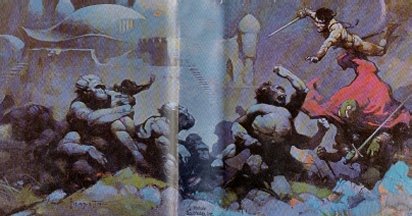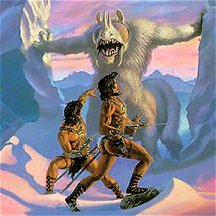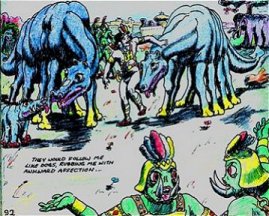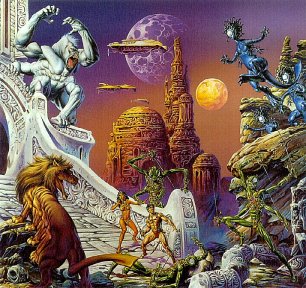 The
frequent criticism of Burroughs Barsoom is that it makes no ecological
sense. On Earth, the predator prey ratios are fairly consistent,
with one lion to one hundred gazelles or something like that.
Yet on Barsoom, John Carter seems to encounter nothing but predators.
Every time he turns around he has to fight a Banth, a White Ape or an Ulsio
or some other monsters. What the hell are these predators eating,
there's no prey. For the world to make sense, John Carter would
have to be struggling knee deep in Thoat droppings.
The
frequent criticism of Burroughs Barsoom is that it makes no ecological
sense. On Earth, the predator prey ratios are fairly consistent,
with one lion to one hundred gazelles or something like that.
Yet on Barsoom, John Carter seems to encounter nothing but predators.
Every time he turns around he has to fight a Banth, a White Ape or an Ulsio
or some other monsters. What the hell are these predators eating,
there's no prey. For the world to make sense, John Carter would
have to be struggling knee deep in Thoat droppings.
Actually, this comes about from a fundamental
misunderstanding of the Martian ecology, and a misapprehension of what
is really going on.
One of the critical things we have to understand
about the Martian ecology of John Carter's time is that it has clearly
undergone a catastrophic mass extinction.



This is not a wild guess. Take a look at
the remaining species: The ten-legged dinosaur-sized Zitidars,
the eight-legged thoats, the banths, calots, white apes, soraks, etc.
These are all highly evolved and fairly distinctive creatures. They
inevitably came from an extensive evolutionary line, actually, from several
individual lines, and evolutionary lines frequently branch.
If we look at Earth, for example, we do not have
only one species of hoofed animal, but hundreds. A creature
like a Moose has a range of cousins ranging from close relatives like deer,
antelope, cattle, bison, sheep and goats, to more distant hoofed relatives
like rhinoceri and elephants. We do not have only one or two
species of predator, but rather, cats differentiate into Lions, Tigers,
Cheetahs, Pumas, Leopards and Panthers, canines differentiate into dogs,
wild dogs of different sorts, wolves, coyotes and foxes. Even rodents
differentiate to everything from squirrels to beavers. Only
comparatively rarely does an evolutionary line wind up with a single representative,
like horses or elephants, and in those cases, it is apparent from fossil
records that related species existed but were pruned away.
But on Barsoom, we appear to have nothing but
single evolutionary lines. This is hardly plausible.
We might expect one or two in a diverse fauna, but hardly single representative
after single representative. The closest we get to indications
of related species is with the Green Man and the White Ape, who are clearly
distinct but closely related species. More distantly, Soraks
and Apts are also six-limbed creatures like the Green Man and White Ape.
But the gulf between Soraks, Apts and their cousins suggest a far richer
evolutionary lineage than the current representatives suggest. Where
are these other species?
 The
Banth, an ‘eight-legged’ Barsoomian lion, on the basis of the number of
limbs, seems to be distantly related to the Thoat. Again, this suggests
a well developed and rich evolutionary lineage where predator and herbivore
parted ways and evolved into quite different creatures. But
this evolution should have produced more varieties of each. Where
are they?
The
Banth, an ‘eight-legged’ Barsoomian lion, on the basis of the number of
limbs, seems to be distantly related to the Thoat. Again, this suggests
a well developed and rich evolutionary lineage where predator and herbivore
parted ways and evolved into quite different creatures. But
this evolution should have produced more varieties of each. Where
are they?
Obviously, they're all dead Jim. Most
of the hypothetical additional creatures off the six legged, and the two
eight legged lines of evolution are no longer around. They are extinct.
The implication is that the majority of species of Barsoom are now extinct.
The same likely holds true for plant species.
A world with oceans and abundant waters produces a massive profusion of
plant life occupying a massive array of ecological niches.
With the desertification of the planet, most of those niches are gone.
At an estimate, somewhere between 75% and 80%
of all the land species, plant and animal, that were extant prior to the
droughts and desiccation of the seas are now extinct.
Most of the planet's remaining biodiversity is
to be found in remnant ‘island ecologies.’ The two big ones are the
Valley Dor and the Toonolian Marshes. There are smaller pockets
of biodiversity remaining in the Kaolian Forest, the Invak Forest, the
salt Marshes of Gathol, Bantoom, Kamtol, Ghasta and a few other small possible
pockets.
These ‘islands’ doubtless contain specialized
species that were particular to those regions all along. But there
is also evidence that these areas are the last refuges for species which
were previously widely distributed. Consider the case of the
Malagor, whose range formerly extended over a substantial territory, but
was believed extinct until a small population was rediscovered in the Toonolian
marshes.
 However,
the extent of the devastation can be appreciated in the fact that these
areas make up less than 10% of the planet's surface area. It
is likely that they make up less than 5% of the surface area.
If we take these small isolated areas out of the equation, the extent of
species depletion and biodiversity loss in the rest of Barsoom is probably
up around 99%.
However,
the extent of the devastation can be appreciated in the fact that these
areas make up less than 10% of the planet's surface area. It
is likely that they make up less than 5% of the surface area.
If we take these small isolated areas out of the equation, the extent of
species depletion and biodiversity loss in the rest of Barsoom is probably
up around 99%.
With respect to sea and ocean species, the level
of extinction is definitely at or near 99%. Only in Korus and
Omean would diminished sea populations survive in any or numbers diversity.
Some species of fish fish were noted in the Ghasta region, and likely exist
in the Toonolian marshes and other areas. But at the same time, red
men in Ghasta were completely unfamiliar with fish, which in turn suggests
that there are no significant fish populations in canals or rivers.
The the polar ocean, and the Hellas basin fish and sea life populations
must be deemed to be entirely extinct.
And this leaves us with what?
Not, unfortunately, the Barsoomian equivalent of Giraffes and Birds of
Paradise. The most specialized creatures have all died off.
All but the hardiest creatures, adapted for the most marginal climates
have died off. We are left with a species poor ecology.
But the survivors.... The survivors are
tough. And more than that, they're adaptable and not terribly
specialized. Earth is currently undergoing a mass extinction,
and its entirely possible that we might wind up doing for ourselves as
well. It is easy to imagine some future Earth being occupied by nothing
but rats, rabbits, raccoons, crows, gulls and dogs. These are
the hardiest, most adaptable, most generalized and omnivorous species of
Earth.
This then, represents the remnants of the martian
ecology. The toughest weed species on the planet, the most incorrigible
pests and vermin and scavengers, the least discriminating of the omnivores.
And, most likely, they represent species previously
adapted to harsh, arid desert conditions, and well equipped to survive
in these situations. Essentially, desert species have spread
through the planet.
So lets turn to the Banth. The reality
is that the Banth is not really the Barsoomian lion, though there may be
some resemblance. Nor is the Calot truly a Barsoomian dog.
What the Banth really is, is the Barsoomian Bear.
It is a powerful, voracious and skillful Martian omnivore.
The question is, what does a Banth eat when John Carter is not around?
The same thing that thoats eat. The moss and the few remaining
plants and shrubs that make up the Barsoomian botany. The Banth
eats meat of course, any meat it can catch or kill. But most
of its diet is the vegetation. And of course, Banths, as large
herbivore/omnivores in a very poor environment, are extremely territorial.
The greenery isn't enough to support competing herbivores as well, so the
Banth is highly motivated to eliminate the competition, who become fine
dining.
The real role of the Banth in the relic Martian
ecology is a highly territorial and aggressive apex herbivore which kills
and eats rival herbivores. It may even prefer meat, but basically,
it eats what it has before it.
 By
the same token, the Calots are a smaller, but equally generalized omnivore/scavenger.
More sociable and adaptable than the Banth, as well as highly intelligent,
they have found a degree of toleration and acceptance at the fringes of
Green and Red Martian societies.
By
the same token, the Calots are a smaller, but equally generalized omnivore/scavenger.
More sociable and adaptable than the Banth, as well as highly intelligent,
they have found a degree of toleration and acceptance at the fringes of
Green and Red Martian societies.
The Great White Apes, of course, are another adaptable
and intelligent omnivore/scavenger, who have found viable habitats in dead
cities and badlands.
Meanwhile, the Ulsio is probably the most generalized
of all, not just an omnivorous carnivore/herbivore, but likely an insectivore,
a carrion and offal eater, and a wood gnawer. Widely distributed,
this tunneling creature is closest to the terrestrial rat.
 Creatures
such as Thoats and Zitidars, in contrast, seem to exist only in the context
of Red Man or Green Man habitation. While it is likely that
there are wild populations, most of the species are domesticated animals.
The reality is that the Thoat and Zitidar are not sufficiently well adapted
to much of the harsh Barsoomian environment to survive without the help
of intelligent species. The Banths and Calots, the true dominant
herbivores would out compete them, and as predators, would simply hunt
them down.
Creatures
such as Thoats and Zitidars, in contrast, seem to exist only in the context
of Red Man or Green Man habitation. While it is likely that
there are wild populations, most of the species are domesticated animals.
The reality is that the Thoat and Zitidar are not sufficiently well adapted
to much of the harsh Barsoomian environment to survive without the help
of intelligent species. The Banths and Calots, the true dominant
herbivores would out compete them, and as predators, would simply hunt
them down.
Apart from the Banths and Calots, and the intelligent
species with their companion animals, the bulk of the Martian ecology is
almost bare. We have likely only a handful of small common
species.
There are, of course, ecological islands, possibly
a number of them of varying sizes, which preserve plant and animal species,
but these species are relentlessly confined to their ‘island’ habitats.
However, the odds are that these ecological ‘islands’ are not particularly
stable. They are isolated not by oceans and seas, but by desert and
subsistence level lands, which mean that the surviving ‘catastrophe’ species,
for the most part, have access to them. Of even more concern, the
stable conditions in these islands are the product of geological and meteorological
flukes. Flukes can change without substantial notice.
Further, most of them are too small to be truly self sustaining over any
long period. The likelihood is that most of the smaller ‘islands’
have experienced and will continue to experience simplification.
The most vulnerable species will continue to disappear from these areas.
The insectlike Sith, formerly an apex predator in the Kaolian forest is
considered to be near extinction.
It is a disturbing fact that many of the ‘islands’,
including some as large as Omean and Dor/Korus, as well as smaller and
medium sized regions like Kamtol, Ghasta, Bantoom, etc., appear to have
survived simply because they were largely unknown to their neighbors and
the Barsoomian population in general.
All of this indicates that while Mass Extinction
has stabilized in most of Barsoom, it is likely to continue within the
‘island’ zones.
Because the source of Barsoom's extinction event
appears to be massive climactic change and environmental desiccation, it
seems unlikely that these factors will change. For better or worse,
Barsoom's current configuration, bereft of water with a borderline atmosphere,
will either continue indefinitely or worsen.
Thus, the likelihood is that life will continue
to subsist at low densities on Barsoom, with an increasingly simplified
ecology of increasingly hardier desert-adapted species.

Mars
Art by Joe Jusko


![]()

![]()